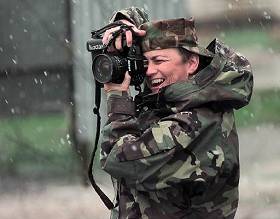





Women in Combat - Time for a Review
June 24, 2001

n 1991, two highly publicized events involving women in uniform changed the armed forces forever. One was Desert Storm, which deployed unprecedented numbers of women to the Persian Gulf under the watchful cameras of CNN. The other agent of change was the Navy's Tailhook scandal, involving besotted male aviators who allegedly abused female officers in a Las Vegas hotel corridor.
Female officers also engaged in "conduct unbecoming," but only the men were punished by overly zealous investigators. Scores of careers were ruined, but outraged critics demanded more.
High-ranking admirals, on the defensive and eager to make amends, felt obligated to yield on matters of policy. One of the most vocal feminists in Congress, Patricia Schroeder of Colorado, took advantage of the Navy's embarrassment to push a paradoxical idea. Sexual harassment was a problem, she said, and putting women in combat was the solution.
Like most feminist theories, this one made no sense. It suggested that abuse of women in a hotel corridor was wrong, but abuse of women at the hands of the enemy would be perfectly all right. Many members of Congress were eager to recognize the accomplishments of women who had served in the Persian Gulf War, but they were still reluctant to vote for full repeal of women's combat exemptions. So they voted to repeal the law exempting women from combat aviation, and established a blue-ribbon presidential commission to find out what that would mean.
Following months of hearings, base visits and consultation with combat veterans and civilian experts, a majority of commissioners recommended that women should continue to be exempt from most combat assignments on land, sea, and in the air. Commission members based their decision on physical differences and other practical matters, but they also expressed concern for American cultural values. Putting women in combat would signal acceptance, and even encouragement, of deliberate violence against women.
Green lights for Pentagon feminists
The commission adopted its recommendations on election day, 1992 - the same day that President George Bush lost the election to Bill Clinton. The new administration ignored the panel's recommendations, and quickly began the process of overturning established policy. Then-Secretary of Defense Les Aspin announced a new, sanitized definition of "direct ground combat," which eliminated "risk of capture" as a factor limiting women's assignments. The Pentagon also dropped long standing "risk rules" that exempted non-combatant women from assignments close to a battle zone.
Follow-up directives soon authorized the placement of women in hundreds of occupations in or near previously closed combat units, which directly engage the enemy. In the same year, with the encouragement of Tailhook-chastened admirals, Congress voted to repeal the law exempting women from long-term deployments on most combatant ships.
At that point, all lights were green for Pentagon feminists to impose their will on the military, even though their views had little in common with the majority of military women. A 1997 Rand survey found that 79% of enlisted women and 71% of female noncommissioned officers said they would not volunteer for combat. An earlier survey found that 34% would quit if ordered into combat along with the men.
None of that mattered to Pentagon feminists, who promoted an even more far-reaching goal: changing the culture of the male-dominated military. One of the most prominent advocates of this idea was Duke Law Professor Madeline Morris, who became a paid advisor to then-Secretary of the Army Togo D. West, Jr.

Dr. Morris advocated an "ungendered vision," which would treat male and female soldiers as wholly interchangeable beings. She called for the eradication of "masculinist" influences that she considered conducive to rape, and came up with a novel idea to reduce sexual tensions. In a Law Journal article, Professor Morris suggested that sensitivity trainers could instill an "incest taboo," so that men and women would "bond" as brothers and sisters.
Secretary West and his Assistant for Manpower and Personnel, civilian attorney Sara Lister, rushed to get women into multiple launch field artillery and special operations aircraft. An angry mob ambushed a special operations helicopter in Somalia, and crew members were brutalized or killed. Graphic photos of the casualties led to the quick withdrawal of American troops.
Alarmed Army generals successfully blocked the most extreme elements of the West/Lister agenda, but the Pentagon's Defense Advisory Committee on Women in the Services (DACOWITS), a mostly civilian feminist advocacy group with direct access to the Secretary of Defense, continues to push for the same goals and more.
Assistant Secretary Lister, who was later forced to resign because she called the Marines "extremist," did get the Army to take significant incremental steps in the wrong direction. The current assignment of women to air cavalry helicopters, which routinely deploy in close tandem with artillery and armored units, virtually guarantees that in future wars women will be shot down, killed, or captured as prisoners of war. The new policy was promoted as a triumph for equal rights, even though female casualties and prisoners would not have an equal opportunity to survive.
Secretary West and Lister also reinstated co-ed basic training, which had been tried for five years starting in the Carter administration. The experiment failed because women suffered excessive injuries, and men were not being challenged enough. Many tests have shown that even with extensive physical conditioning, women are 50-60% less strong than men, and have about 25-30% less aerobic capacity needed for endurance.
To get around realities such as this, and to avoid failure for co-ed basic training the second time around, civilian Army officials changed the regime and redefined "success" in terms of women's morale. Early focus group surveys found that women's self-esteem improved by 14 points, while the men's morale sank by 17.
Co-ed basic training incorporated gender-normed tests, adjusted for physical differences, and less-demanding requirements, such as map-reading or first-aid, were assigned greater importance. Focus group evaluated "cohesion," but only in terms of feelings and emotion, rather than combat readiness.
Gender-adjusted scores are considered more "fair" because they measure "equal effort, not results". The system does not inspire confidence, because everyone knows that there is no gender-norming on the battlefield. No one would consider adopting the concept in non-lethal combat, such as the Army-Navy football game.
A recent study on the culture of the military done by the Center for Strategic and International Studies (CSIS) found that only one-third of junior enlisted men believed women would pull their load in combat, and 44% of junior enlisted women agreed. This is not a reflection of sexism, but honest concern about mission accomplishment and survival.
Highest attrition rates
The 1990's version of gender-mixed training also introduced co-ed barracks. The distraction of sexual attraction undermined discipline. Instructors forced to chaperone found it more difficult to instill military skills and values needed to prepare recruits for advanced training, and a completely different way of life.
In 1996, sensational sex scandals involving drill sergeants and female trainees surfaced at Aberdeen Proving Ground in Maryland. Lurid reports emerged from basic and advanced training facilities in all the services, except the Marine Corps, which continued to train men and women separately. In many cases the sexual misconduct was consensual but exploitive, and always corrosive to good order and discipline.
Congress considered legislation to repeal co-ed basic training, which passed in the House in 1998. But service chiefs who were already committed to the program testified that they did not want to reverse it. Official claims of "success," however, were contradicted by worrisome evidence of continuing misconduct and personnel losses.
According to a General Accounting Office report, 1998 rates for first-term (four-year) attrition escalated to almost 36% in all of the services, with the Army's attrition rate highest at 39%. Losses among women averaged about 45%, including 26% who separated due to pregnancy. By contrast, attrition in the Marine Corps continued a downward trend.
These problems have occurred not because of uniformed women, but because of Pentagon social engineers who disregard the power of sexuality, and the weakness of human nature. Collateral policies, such as rules to accommodate pregnant sailors on combatant ships, make military life more difficult or dangerous for everyone.

Women make good sailors, but the evacuation rate for women serving on ships is about two-and-half times that of men-most often due to medical problems including pregnancy. During a recent deployment of the carrier Theodore Roosevelt, for example, 45 of 300 women did not deploy or complete the cruise due to impending childbirth. Eleven of the 45 were flown off the ship while underway.
The unplanned loss of any sailor from a combat ship imposes considerable strain on crewmembers, especially in technical areas. Properly trained replacements are usually not available. The imposition of similar problems on submarines, which operate in an undersea environment more dangerous than space, would be far worse.
Nevertheless, in a 1999 speech Secretary of the Navy Richard Danzig called the submarine force a "white, male bastion," and suggested that the silent service should begin, for political reasons, to plan for the assignment of women to submarines. The tax-funded DACOWITS committee, which disregards the views of civilian and military women who do not support the feminist agenda, endorsed the idea with a unanimous vote.
DACOWITS members showed little interest in a definitive report, kept under wraps since 1995, which should have torpedoed the idea for good. The report, issued by the respected firm Science Applications International Corporation (SAIC), described the reality of life inside the cramped quarters of a submarine, which have been compared to the inside of a clock.
On an attack submarine, for example, it is standard operating procedure to "hot bunk" about 40% of the crew. That means that three men must share two bunks in rotating 6-hour shifts, and sailors sometimes have to sleep in noisy torpedo rooms. Desirable bunks (away from passageways) are strictly assigned by rank and/or seniority. Setting aside preferred accommodations for the exclusive use of women would be a serious blow to crew morale.
A drawing displayed in the SAIC report superimposed the living spaces of an attack sub on an area slightly wider but much shorter than the cabin of a civilian 747 aircraft. The report explained that the living area for more than 130 people is equivalent to a medium-size house, and human living space is about one-half to one-third of that available on a small surface ship. Piping and electrical modifications for gender-mixed crews may not be possible without lengthening the ship, or removing equipment needed for combat capability.
The SAIC report also raised serious concerns about the toxic effects of carbon monoxide and other atmospheric elements on a developing fetus. These elements, which are not harmful to adult sailors, cannot be eliminated from the closed environment of a submarine. Mandatory pre-deployment pregnancy tests would make sense, but feminists reject them as an infringement on women's rights.
Unplanned surfacings and hazardous helicopter evacuations, made necessary by more frequent medical and disciplinary problems, would endanger crewmembers and compromise the stealth mission of the submarine. If confronted by a pregnant submariner who is worried about birth defects in the middle of a 75-day deployment, what is a ship captain to do?
In the gender-integrated military, scenarios such as this are far more complicated than questions about what it would take to win the Cold War. Field commanders must deal with such issues every day, even as they struggle to accomplish missions that have increased 300%, with forces reduced by one-third to one-half
The purpose of the ongoing exercise is not to strengthen national defense, or even to protect the interests of the majority of military women who deserve the nation's support. The underlying goal is to satisfy feminist critics, put their theories to the ultimate test, and try to elevate a few women to four-star rank, eligible to become Chairman of the Joint Chiefs of Staff. Never mind that lives might be needlessly lost and national security compromised in pursuit of careerist goals.
Denmark, Canada, and the Netherlands have consciously chosen to advance careers at the expense of combat readiness, but these are not world powers. They depend on the United States for military defense in a still-dangerous world.
Preparing for real war
Some Pentagon leaders have tried to stifle comments about what is going on. The Navy's policy on pregnancy forbids negative comments about unplanned losses, even if female crewmembers become non-deployable for months at a time. The overly-generous policy offers medical, housing and educational benefits, regardless of marital status or number of pregnancies. As in the civilian world, if you accommodate and subsidize single parenthood, you get more of it. Everyone talks about soldiers on food stamps, but no one wants to admit that the problem will not be corrected until the military stops encouraging single parenthood.
Truth, it seems, is the first casualty of social engineering. Dissembling is demoralizing, because it erodes the confidence servicemembers must have in their leaders. The February 2000 CSIS study found that only 35% of servicemen surveyed agreed with the statement: "When my service's senior leaders say something, you can believe it's true." Only 44% of junior officers expressed confidence that their own superiors "have the will to make the tough, sometimes unpopular decisions that are in the best long-term interest of the service. "
Members of Congress, who are constitutionally responsible for oversight of the armed forces, must give permission to military leaders to make tough, sometimes controversial decisions. The next commander in chief must demand complete candor about what has happened in recent years, and take immediate steps to end ill-advised social engineering.
In her new book The Kinder, Gentler Military, Stephanie Gutmann shines a bright light on the consequences of "ungendered visions" in actual practice. The book describes scenes of women struggling to compete in a world of false equality, which sometimes appear comic, but really foretell tragedy in the making. No one should have to lose their life in pursuit of feminist fantasies.
The volunteer force is losing experienced people, and recruiters are hard pressed to meet their goals. This is the only military we have, and our national security depends on it. Some other institution can deal with gender wars, but the military must be prepared for real war.
Text source: Elaine Donnelly, Center for Military Readiness, July 2000
© 2001 CheckPoint |














